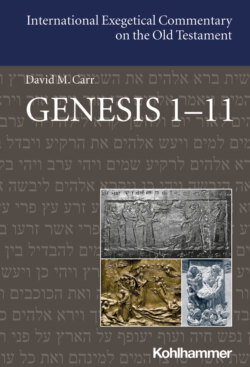Читать книгу Genesis 1-11 - David M. Carr - Страница 18
На сайте Литреса книга снята с продажи.
Moving to Commentary
ОглавлениеThe following commentary builds on and presupposes the above discussions. As with other volumes in the series, each section of this commentary begins with a translation of the text under discussion, followed by philological and text-critical annotations on the translation. Since there is little chance of this translation being adopted in any large-scale edition of the Bible, it often tends toward the formal correspondence end of the continuum, risking awkwardness in the hopes of conveying specific aspects of the Hebrew. In several cases, larger scale text-critical or translation issues are discussed in an excursus following these annotations. As noted in the preface, the discussion does not attempt to provide a full reference to the mountain of critical scholarship regarding elements in Gen 1–11, especially given the range of excellent commentaries recently or soon appearing that do more of that.68 Instead, I have reduced this volume’s size by focusing its diachronic, textual, and philological discussions on issues that appear particularly pertinent to the following commentary.
Diachrony and SynchronyThe following commentary then integrates diachronic and synchronic discussions in different ways, depending on the particular problems presented by the given text. Each section starts with a diachronic prelude providing an overview of the basic diachronic profile of the text to be treated. This prologue focuses on separate textual precursors to the text and any widely-agreed upon distinctions of non-P and P material within it. These diachronic reflections then organize and inform the following synchronic overview and commentary in diverse ways. In some cases, such as Gen 1:1–2:3; Gen 2:4–3:24; or even Gen 5, the given text block is formed largely from one, widely-agreed-upon diachronic level, and so the commentary moves directly from the diachronic prologue to a synchronic overview of the overall text and more detailed commentary on its parts. In the case of the story of Babylon (Gen 11:1–9) most diachronic discussion is postponed until after a close reading of the text at hand. Finally, in the cases of the Noah-flood story (Gen 6:5–9:17) and the overview of post-flood peoples (Gen 10), the given text represents a mix of P and non-P strata, each of which were composed for different synchronic contexts. In these cases, I initially comment on the different textual strata separately, attending to how they work in their original synchronic context, before turning to some final discussion of the composite whole. Overall, years of work on these chapters have shown me ever more that “no one size fits all” on this question, especially given the way synchronic and diachronic modes of analysis are intricately interrelated.
The above paragraph underlines the extent to which this commentary diverges from some understandings of the adjective “synchronic” as pertaining primarily to a non-historical reading of a final form of the biblical text.69 This is especially relevant for Gen 1–11 insofar as one follows the above-outlined source-critical model for the formation of Gen 1–11. Though the redactor-conflator of P and Non-P did work to create a meaningful text, much of his work seems to have been dictated by the constraints of combining large swathes of two, often overlapping and divergent narratives.70 For example, the ordering of the Eden story in Gen 2–3 after the seven-day creation account in Gen 1 is determined first and foremost by the respective contents of each block of material. Genesis 2–3 makes the most sense as a specifying follow-up to the creation of plants, animals, and humanity in Gen 1, and the reverse order would not work. Insofar as such a (conflational) decision was required on a more mechanical level, one must take care about making grand assumptions about a masterful “final redactor” creating a particular theological or literary synthesis by way of putting Gen 1:1–2:3 before Gen 2:4ff.71 The following commentary will consider some likely cases for redactional intervention, particularly in the discussion of the flood narrative and the overview of post-flood peoples. Nevertheless, many final form readings of a conflated text like Gen 1–11, though potentially meaningful for various reading communities, cannot plausibly claim to represent a meaning that was intentionally embedded by anyone within the ancient text itself.
SynthesisFor this reason, this commentary’s discussion of the significance of the text’s final form is often reserved for the synthesis sections that conclude each section. These synthesis sections aim to summarize the preceding diachronic and synchronic analyses and continue the exegetical discussion. In particular I try to provide some connections here to interpretations of Gen 1–11 that stand outside the historical approach adopted through the bulk of this commentary. Such reflections are only selective, brief, and illustrative. Nevertheless, they attempt to underline the partial nature of the analysis advanced here. This commentary is focused on providing historically-oriented diachronic and synchronic reflections that contribute to a broader interpretive conversation around these texts. It cannot claim to offer a definitive exegesis of them, especially given their above-described multi-voiced and intertextual character.
